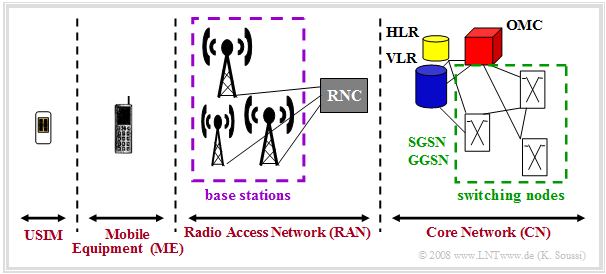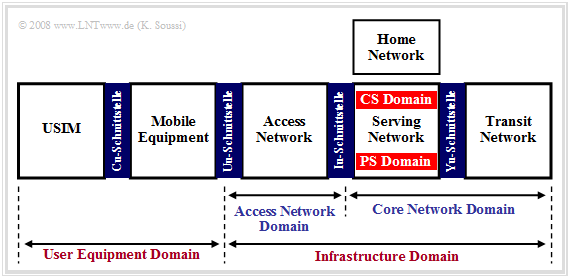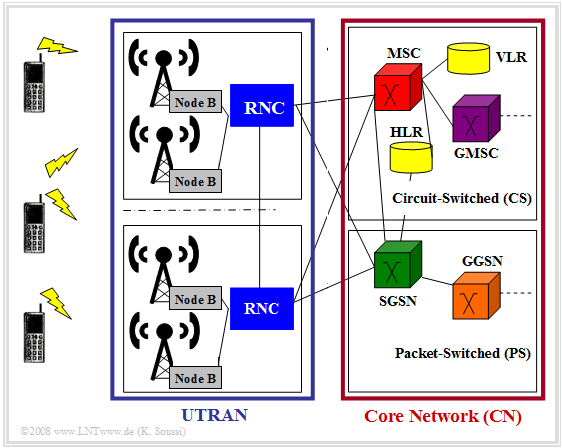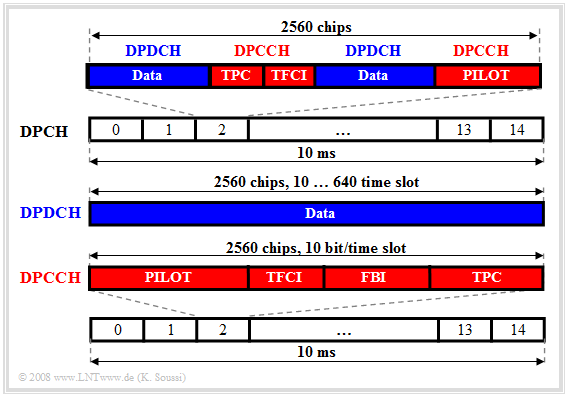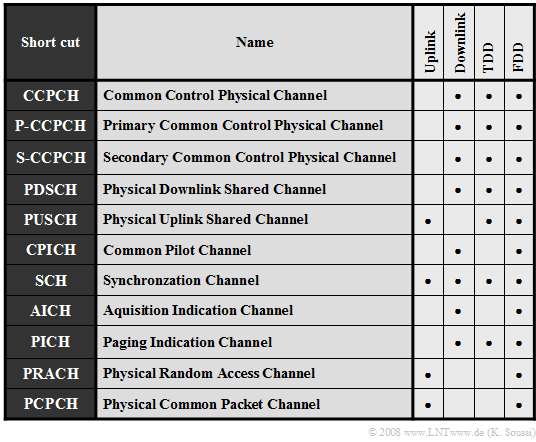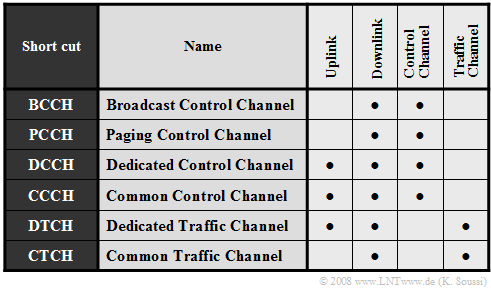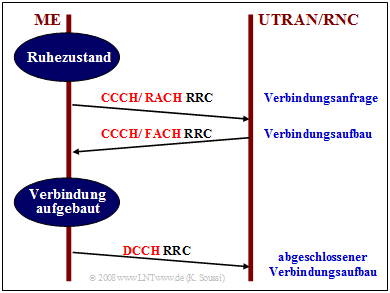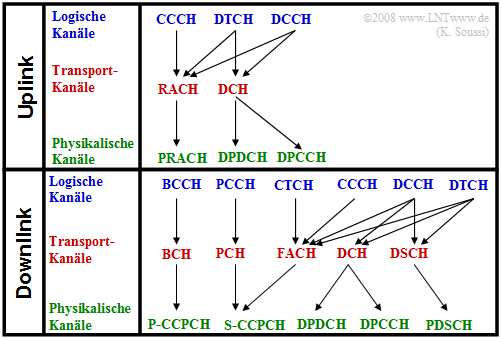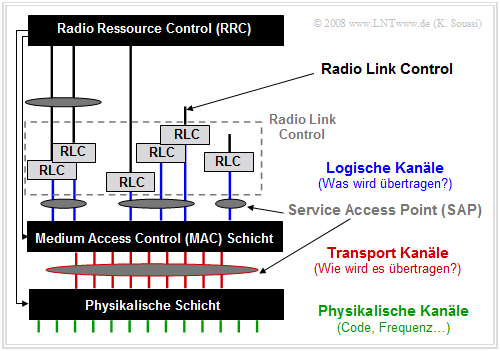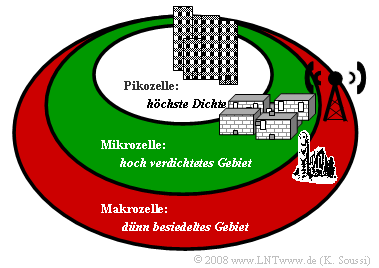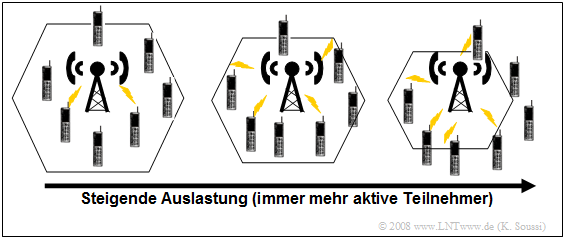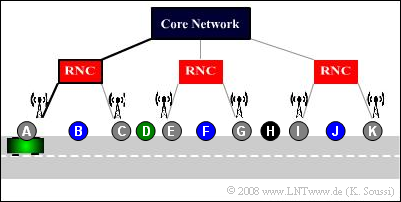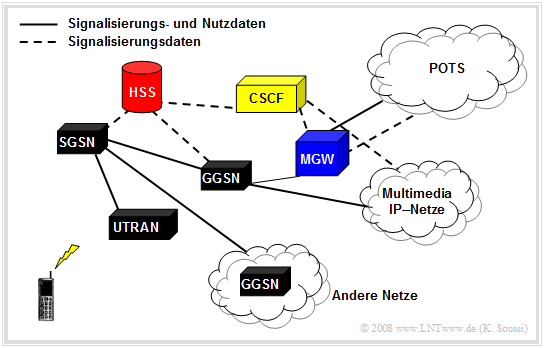Difference between revisions of "Examples of Communication Systems/UMTS Network Architecture"
| Line 2: | Line 2: | ||
{{Header | {{Header | ||
|Untermenü=UMTS – Universal Mobile Telecommunications System | |Untermenü=UMTS – Universal Mobile Telecommunications System | ||
| − | |Vorherige Seite= | + | |Vorherige Seite=General Description of UMTS |
| − | |Nächste Seite= | + | |Nächste Seite=Telecommunications Aspects of UMTS |
}} | }} | ||
| − | == | + | ==Basic units of the system architecture == |
<br> | <br> | ||
| − | + | In the architecture of UMTS networks, a distinction is made between four basic logical units. The interaction of these units enables the operation of the entire network. | |
| − | [[File:EN_Bei_T_4_2_S1_v1.png|right|frame| | + | [[File:EN_Bei_T_4_2_S1_v1.png|right|frame|Basic units of UMTS system architecture]] |
| − | In | + | In the graphic you can see: |
| − | *$\rm Universal \ Subscriber | + | *$\rm Universal \ Subscriber \ Identity \ Module \ (USIM)$ - The USIM is a removable IC card that contains radio information and information for unique identification and authentication of the subscriber. It differs from the conventional SIM card in that it has enhanced security features, larger memory capacity, and an integrated microprocessor that is used to run programs. |
| − | |||
| − | |||
| − | |||
| − | |||
| + | *$\rm Mobile \ Equipment \ (ME)$ - Equipped with a USIM card, the UMTS terminal provides both the radio interface for data transmission and the user controls. It differs from the common GSM mobile station in that it offers enhanced functionality, multimedia applications, and more complex and diverse services. In many cases, the designations ''User Equipment'' (UE) and ''Terminal Equipment'' (TE) can also be found. | ||
| + | *$\rm Radio \ Access \ Network \ (RAN)$ - This refers to the fixed network infrastructure of UMTS, which is responsible for radio transmission and related tasks. The RAN contains the base stations (''Node B'') and the control nodes (''Radio Network Controller'' - RNC) that connect the RAN and the ''Core Network'' . | ||
| + | *$\rm Core \ Network \ (CN)$ - This represents the wide area network and is responsible for data transport. It contains switching facilities (SGSN, GGSN) to external networks and mobility and subscriber management databases (HLR, VLR). The ''Core Network'' also contains the network management facilities (''Operation and Maintenance Center'' - OMC) required to manage the overall network. | ||
| − | == | + | ==Domains and interfaces == |
<br> | <br> | ||
| − | [[File:P_ID1512__Bei_T_4_2_S2_v1.png|right|frame| | + | [[File:P_ID1512__Bei_T_4_2_S2_v1.png|right|frame|Basic units of the UMTS system architecture]] |
| − | + | The units of the UMTS network listed on the last page are grouped into so-called '''domains'''. | |
| − | + | This refers to functional blocks that serve to standardize and study the functional units and interfaces within the UMTS network. | |
| − | + | Two main categories of domains are distinguished, viz. | |
| − | * | + | *the ''User Equipment Domain'', and. |
| − | * | + | *the ''Infrastructure Domain''. |
<br clear=all> | <br clear=all> | ||
| − | + | The $\rm User \ Equipment \ Domain$ contains all functions that enable access to the UMTS network, such as encryption functions for the transmission of data via the radio interface. One can divide this domain into two domains: | |
| − | * | + | *the '''USIM Domain''' - the SIM card is a part of this domain; |
| − | * | + | *the '''Mobile Equipment Domain''' - it contains all the functions that a terminal device has. |
| − | + | These two domains are connected via the ''Cu interface''' which includes the electrical and physical specifications as well as the protocol stack between the USIM card and the terminal device. This allows USIM cards from different network operators to operate with all terminal devices. | |
| − | + | Another important interface is the ''Uu interface'', which establishes the radio link between the mobile station and the ''Infrastructure Domain'' . | |
| − | + | The $\rm Infrastructure \ Domain$ is divided into the following two domains: | |
| − | * | + | *The '''Access Network Domain''' groups all base stations - called "Node B" in UMTS - and the functions of the ''Radio Access Network'' (RAN). |
| − | * | + | *The '''Core Network Domain''' is responsible for the most error-free transmission and transport of user data. |
| − | + | These two domains are connected via an ''Iu interface''' . This interface is responsible for data switching between the ''Access Network''' and the ''Core Network''' and is the separation between the transport layer and the radio network layer. | |
| − | + | The ''Core Network Domain'' can in turn be divided into three sub-domains: | |
| − | * | + | *The ''Serving Network Domain'' contains all functions and information necessary to access the UMTS network. |
| − | * | + | *The ''Home Network Domain'' contains all functionalities that are performed in the home network of a (foreign) subscriber. |
| − | * | + | *The ''Transit Network Domain'' is a so-called transit network. This only takes effect if database queries are to be performed in the subscriber's home network and the ''Serving Network'' is not directly connected to the ''Home Network'' . |
== Access level architecture == | == Access level architecture == | ||
<br> | <br> | ||
| − | + | UMTS networks support both circuit switching and packet switching: | |
{{BlaueBox|TEXT= | {{BlaueBox|TEXT= | ||
| − | $\text{ | + | $\text{Distinctive features:}$ |
| − | * | + | *In '''circuit switching''' (CS), the radio channel is assigned to the two communication partners for the entire duration of the connection until all information has been transmitted. Only then is the channel released. |
| − | * | + | *In '''Packet Switching''' (PS), the participants cannot use the channel exclusively, but the data stream is divided in the transmitter into small data packets - each with the destination address in the header - and only then sent. The channel is shared by several participants}} |
| − | [[File:EN_Bei_T_4_2_S3_v1.png|right|frame| | + | [[File:EN_Bei_T_4_2_S3_v1.png|right|frame|Structural design of a UMTS network]] |
| − | + | The two modes can also be recognized in the access level of the UMTS network in the ''Core Network''' (CN), which is shown opposite. | |
| − | + | The access layer can be divided into two main blocks: | |
| − | + | The $\rm UMTS \ Terrestrial \ Radio \ Access \ Network \ (UTRAN)$ ensures radio transmission of data between the transport layer and the radio network layer. | |
| − | + | The UTRAN includes the base stations and the control nodes, whose functions are mentioned below: | |
| − | * | + | *A '''Node B''' - as a UMTS base station is usually called - includes the antenna equipment as well as the CDMA receiver and is directly connected to the ME radio interfaces. Its tasks include data rate adaptation, data and channel (de)coding, interleaving, and modulation or demodulation. Each "Node B" can power one or more cells. |
| − | * | + | *The '''Radio Network Controller''' (RNC) is responsible for controlling the base stations. Likewise, within the cells, it is responsible for call acceptance control, encryption and decryption, ATM switching, channel assignment, handover and power control. |
<br clear=all> | <br clear=all> | ||
| − | + | The $\rm Core \ Network \ (CN)$ is responsible for switching the data (both ''circuit-switched'' and ''packet-switched'') within the UMTS network. | |
| − | + | For this purpose, it contains at ''circuit-switched'' the following hardware and software components: | |
| − | * | + | *The '''Mobile Services Switching Center''' (MSC) is responsible for call routing, localization, authentication, handover and encryption of subscriber data. |
| − | * | + | *The '''Home Location Register'''' (HLR) contains all subscriber data such as tariff model, telephone number, and the associated service-specific authorizations and keys. |
| − | * | + | *The '''Visitor Location Register'''' (VLR) contains location information about locally registered users and copies of records from its HLR. This data is dynamic: As soon as the subscriber changes his location, this information is changed. |
| − | + | In ''packet-switched transmission'' there are the following facilities or registers: | |
| − | * | + | *The '''Serving GPRS Support Node''' (SGSN) is responsible for routing and authentication instead of MSC and VLR and keeps a local copy of the subscriber information. |
| − | * | + | *At '''Gateway GPRS Support Node''' (GGSN) there are transitions to other packet data networks such as the Internet. Incoming packets are filtered by an integrated firewall and forwarded to the appropriate SGSN. |
| − | * | + | *The '''GPRS Register''' (GR) is part of the ''Home Location Register''' (HLR) and contains additional information needed for packet-switched transmission. |
== Physical channels == | == Physical channels == | ||
<br> | <br> | ||
| − | + | Physical channels are used for communication on the physical level of the radio interface and are processed within a base station ("Node B"). A distinction is made between ''dedicated physical channels'' and ''shared physical channels''. | |
| − | [[File:EN_Bei_T_4_2_S4a_v1.png|right|frame| | + | [[File:EN_Bei_T_4_2_S4a_v1.png|right|frame|Construction of the dedicated physical channels]] |
| − | + | The $\rm dedicated \physical \channels$ are permanently assigned to individual communication partners. These include: | |
| − | *''Dedicated Physical Data Channel'' ('''DPDCH''') | + | *''Dedicated Physical Data Channel'' ('''DPDCH''') - This is a unidirectional uplink channel that transports payload and signaling data from higher layers. |
| − | *''Dedicated Physical Control Channel'' ('''DPCCH''') | + | *''Dedicated Physical Control Channel'' ('''DPCCH''') - This control channel contains physical layer information for transmission control, line control commands, and transport format indicators, to name a few examples. |
| − | *''Dedicated Physical Channel'' ('''DPCH''') | + | *''Dedicated Physical Channel'' ('''DPCH''') - This channel includes the '''DPDCH''' and the '''DPCCH''' in the downlink and has a length of $2560$ chips. |
| − | + | The diagram shows the structural design of the '''DPDCH'''' (blue), of the '''DPCCH'''' (red) as well as the enveloping '''DPCH'''. | |
| − | * | + | *In the '''DPCH''', chips are transmitted in $10 \ \rm ms$ exactly $15 - 2560 = 38400$ resulting in chip rate $3.84 \ \rm Mchip/s$ . |
| − | * | + | *The user data in the '''DPDCH''' is split and per time slot - depending on the spreading factor $J$ - between $10$ bits $($falls $J = 256 )$ and $640$ bits $($falls $J = 4)$ bits are transmitted. |
| − | * | + | *In '''DPCCH''', ten control bits are transmitted uniformly per time slot. |
<br clear=all> | <br clear=all> | ||
| − | + | The table lists the \physical \channels$ shared by all participants $\rm. | |
| − | [[File:EN_Bei_T_4_2_S4b.png|right|frame| | + | [[File:EN_Bei_T_4_2_S4b.png|right|frame|Shared channels in UMTS]] |
| − | + | The following describes the characteristics of some selected channels: | |
| − | * | + | *The '''CCPCH''' is a downlink channel with two subchannels. The '''P-CCPCH''' contains data necessary for operation within a radio cell, while the '''S-CCPCH''' contains data responsible for the paging procedure and for the transport of control data. |
| − | * | + | *The '''PDSCH''' and the '''PUSCH''' are shared channels that can transport both payload and control data. The first is solely responsible for the downlink, the second for the uplink. |
| − | * | + | *The '''PRACH''' controls the message transmission of the random access channel '''RACH''', while the '''PCPCH''' is responsible for transporting data packets using the CDMA/CD method. |
| − | + | The following channels are responsible for the control and synchronization of the overall system: | |
| − | * | + | *The '''CPICH''' determines the affiliation of the mobile station to a base station. |
| − | * | + | *The '''SCH''' is used for cell search and synchronization of the mobile station. |
| − | * | + | *The '''AICH''' checks and determines the availability of the system. |
| − | * | + | *The '''PICH''' is responsible for paging during subscriber localization. |
Revision as of 23:25, 31 January 2023
Contents
- 1 Basic units of the system architecture
- 2 Domains and interfaces
- 3 Access level architecture
- 4 Physical channels
- 5 Logische Kanäle
- 6 Transportkanäle
- 7 Kommunikation innerhalb des ISO/OSI–Schichtenmodells
- 8 Zellulare Architektur von UMTS
- 9 What is cell breathing?
- 10 Handover in UMTS
- 11 IP–basierte Netze
- 12 Aufgaben zum Kapitel
Basic units of the system architecture
In the architecture of UMTS networks, a distinction is made between four basic logical units. The interaction of these units enables the operation of the entire network.
In the graphic you can see:
- $\rm Universal \ Subscriber \ Identity \ Module \ (USIM)$ - The USIM is a removable IC card that contains radio information and information for unique identification and authentication of the subscriber. It differs from the conventional SIM card in that it has enhanced security features, larger memory capacity, and an integrated microprocessor that is used to run programs.
- $\rm Mobile \ Equipment \ (ME)$ - Equipped with a USIM card, the UMTS terminal provides both the radio interface for data transmission and the user controls. It differs from the common GSM mobile station in that it offers enhanced functionality, multimedia applications, and more complex and diverse services. In many cases, the designations User Equipment (UE) and Terminal Equipment (TE) can also be found.
- $\rm Radio \ Access \ Network \ (RAN)$ - This refers to the fixed network infrastructure of UMTS, which is responsible for radio transmission and related tasks. The RAN contains the base stations (Node B) and the control nodes (Radio Network Controller - RNC) that connect the RAN and the Core Network .
- $\rm Core \ Network \ (CN)$ - This represents the wide area network and is responsible for data transport. It contains switching facilities (SGSN, GGSN) to external networks and mobility and subscriber management databases (HLR, VLR). The Core Network also contains the network management facilities (Operation and Maintenance Center - OMC) required to manage the overall network.
Domains and interfaces
The units of the UMTS network listed on the last page are grouped into so-called domains.
This refers to functional blocks that serve to standardize and study the functional units and interfaces within the UMTS network.
Two main categories of domains are distinguished, viz.
- the User Equipment Domain, and.
- the Infrastructure Domain.
The $\rm User \ Equipment \ Domain$ contains all functions that enable access to the UMTS network, such as encryption functions for the transmission of data via the radio interface. One can divide this domain into two domains:
- the USIM Domain - the SIM card is a part of this domain;
- the Mobile Equipment Domain - it contains all the functions that a terminal device has.
These two domains are connected via the Cu interface' which includes the electrical and physical specifications as well as the protocol stack between the USIM card and the terminal device. This allows USIM cards from different network operators to operate with all terminal devices.
Another important interface is the Uu interface, which establishes the radio link between the mobile station and the Infrastructure Domain .
The $\rm Infrastructure \ Domain$ is divided into the following two domains:
- The Access Network Domain groups all base stations - called "Node B" in UMTS - and the functions of the Radio Access Network (RAN).
- The Core Network Domain is responsible for the most error-free transmission and transport of user data.
These two domains are connected via an Iu interface' . This interface is responsible for data switching between the Access Network and the Core Network and is the separation between the transport layer and the radio network layer.
The Core Network Domain can in turn be divided into three sub-domains:
- The Serving Network Domain contains all functions and information necessary to access the UMTS network.
- The Home Network Domain contains all functionalities that are performed in the home network of a (foreign) subscriber.
- The Transit Network Domain is a so-called transit network. This only takes effect if database queries are to be performed in the subscriber's home network and the Serving Network is not directly connected to the Home Network .
Access level architecture
UMTS networks support both circuit switching and packet switching:
$\text{Distinctive features:}$
- In circuit switching (CS), the radio channel is assigned to the two communication partners for the entire duration of the connection until all information has been transmitted. Only then is the channel released.
- In Packet Switching (PS), the participants cannot use the channel exclusively, but the data stream is divided in the transmitter into small data packets - each with the destination address in the header - and only then sent. The channel is shared by several participants
The two modes can also be recognized in the access level of the UMTS network in the Core Network' (CN), which is shown opposite.
The access layer can be divided into two main blocks:
The $\rm UMTS \ Terrestrial \ Radio \ Access \ Network \ (UTRAN)$ ensures radio transmission of data between the transport layer and the radio network layer.
The UTRAN includes the base stations and the control nodes, whose functions are mentioned below:
- A Node B - as a UMTS base station is usually called - includes the antenna equipment as well as the CDMA receiver and is directly connected to the ME radio interfaces. Its tasks include data rate adaptation, data and channel (de)coding, interleaving, and modulation or demodulation. Each "Node B" can power one or more cells.
- The Radio Network Controller (RNC) is responsible for controlling the base stations. Likewise, within the cells, it is responsible for call acceptance control, encryption and decryption, ATM switching, channel assignment, handover and power control.
The $\rm Core \ Network \ (CN)$ is responsible for switching the data (both circuit-switched and packet-switched) within the UMTS network.
For this purpose, it contains at circuit-switched the following hardware and software components:
- The Mobile Services Switching Center (MSC) is responsible for call routing, localization, authentication, handover and encryption of subscriber data.
- The Home Location Register' (HLR) contains all subscriber data such as tariff model, telephone number, and the associated service-specific authorizations and keys.
- The Visitor Location Register' (VLR) contains location information about locally registered users and copies of records from its HLR. This data is dynamic: As soon as the subscriber changes his location, this information is changed.
In packet-switched transmission there are the following facilities or registers:
- The Serving GPRS Support Node (SGSN) is responsible for routing and authentication instead of MSC and VLR and keeps a local copy of the subscriber information.
- At Gateway GPRS Support Node (GGSN) there are transitions to other packet data networks such as the Internet. Incoming packets are filtered by an integrated firewall and forwarded to the appropriate SGSN.
- The GPRS Register' (GR) is part of the Home Location Register (HLR) and contains additional information needed for packet-switched transmission.
Physical channels
Physical channels are used for communication on the physical level of the radio interface and are processed within a base station ("Node B"). A distinction is made between dedicated physical channels and shared physical channels.
The $\rm dedicated \physical \channels$ are permanently assigned to individual communication partners. These include:
- Dedicated Physical Data Channel (DPDCH) - This is a unidirectional uplink channel that transports payload and signaling data from higher layers.
- Dedicated Physical Control Channel (DPCCH) - This control channel contains physical layer information for transmission control, line control commands, and transport format indicators, to name a few examples.
- Dedicated Physical Channel (DPCH) - This channel includes the DPDCH and the DPCCH in the downlink and has a length of $2560$ chips.
The diagram shows the structural design of the DPDCH' (blue), of the DPCCH' (red) as well as the enveloping DPCH.
- In the DPCH, chips are transmitted in $10 \ \rm ms$ exactly $15 - 2560 = 38400$ resulting in chip rate $3.84 \ \rm Mchip/s$ .
- The user data in the DPDCH is split and per time slot - depending on the spreading factor $J$ - between $10$ bits $($falls $J = 256 )$ and $640$ bits $($falls $J = 4)$ bits are transmitted.
- In DPCCH, ten control bits are transmitted uniformly per time slot.
The table lists the \physical \channels$ shared by all participants $\rm.
The following describes the characteristics of some selected channels:
- The CCPCH is a downlink channel with two subchannels. The P-CCPCH contains data necessary for operation within a radio cell, while the S-CCPCH contains data responsible for the paging procedure and for the transport of control data.
- The PDSCH and the PUSCH are shared channels that can transport both payload and control data. The first is solely responsible for the downlink, the second for the uplink.
- The PRACH controls the message transmission of the random access channel RACH, while the PCPCH is responsible for transporting data packets using the CDMA/CD method.
The following channels are responsible for the control and synchronization of the overall system:
- The CPICH determines the affiliation of the mobile station to a base station.
- The SCH is used for cell search and synchronization of the mobile station.
- The AICH checks and determines the availability of the system.
- The PICH is responsible for paging during subscriber localization.
Logische Kanäle
Die logischen Kanäle befinden sich in der MAC (Medium Access Control)–Referenzschicht und werden durch den Typ der übertragenen Daten gekennzeichnet.
Die in der Tabelle zusammengestellten logischen Kanäle lassen sich in zwei Klassen unterteilen, nämlich in
- Kontrollkanäle (Control Channels):
- Über die Kontrollkanäle (mit Endung CCH) werden sowohl Kontrollinformationen (BCCH) als auch Paging–Informationen (PCCH) transportiert. Darüber können auch teilnehmerspezifische Signalisierungsdaten (DCCH) oder Transportinformationen zwischen den Teilnehmergeräten und dem UTRAN (CCCH) ausgetauscht werden.
- Verkehrskanäle (Traffic Channels):
- Über die Verkehrskanäle (mit Endung TCH) werden Teilnehmerinformationen ausgetauscht. Während der DTCH einem mobilen Teilnehmer zum Nutzdatentransport individuell zugewiesen werden kann, wird ein CTCH vorwiegend an alle oder an eine vordefinierte Teilnehmergruppe vergeben.
Transportkanäle
Transportkanäle befinden sich in der physikalischen Schicht des ISO/OSI–Schichtenmodells. Sie
- werden durch die Parameter der Datenübertragung (z.B. die Datenrate) gekennzeichnet,
- gewährleisten die gewünschten Anforderungen bezüglich der Fehlerschutzmechanismen, und
- legen die Art der Datenübertragung – so zu sagen das „WIE” – fest.
Man unterscheidet zwei Klassen von Transportkanälen, nämlich dedizierte und gemeinsam genutzte Transportkanäle.
Zur Klasse der $\rm dedizierten \ Transportkanäle$ (Dedicated Transport Channels – DTCH) gehören die Dedicated Channels (DCH), die Teilnehmern fest zugewiesen werden.
- Ein DCH transportiert sowohl Nutzdaten als auch Kontrolldaten (Handover–Daten, Messdaten, ...) an die höheren Schichten, in denen sie dann interpretiert und verarbeitet werden.
Zu den $\rm gemeinsam \ genutzten \ Transportkanälen$ (Common Transport Channels – CTCH) gehören beispielsweise:
- Der Broadcast Channel (BCH) ist ein Downlink–Kanal, der netzbetreiberspezifische Daten der Funkzelle (zum Beispiel: Access Random Codes zur Signalisierung eines Verbindungsaufbaus) an die Teilnehmer verteilt. Charakteristisch ist seine relativ hohe Leistung und niedrige Datenrate $($nur $\text{3.4 kbit/s)}$, um allen Nutzern einen möglichst fehlerfreien Empfang und hohen Prozessgewinn zu ermöglichen.
- Der Forward Access Channel (FACH) ist ein Downlink–Kanal, zuständig für den Transport von Kontrolldaten. Eine Zelle kann mehrere FACH–Kanäle enthalten, wobei einer der Kanäle eine niedrige Datenrate aufweisen muss, um allen Nutzern die Auswertung seiner Daten zu ermöglichen.
- Der Random Access Channel (RACH) ist ein unidirektionaler Uplink–Kanal. Der Teilnehmer kann damit den Wunsch äußern, eine Funkverbindung aufbauen zu wollen. Außerdem können darüber auch kleine Datenmengen übertragen werden.
- Der Common Packet Channel (CPCH) ist ein unidirektionaler Uplink–Datenkanalfür paketorientierte Dienste und eine Erweiterung des RACH–Kanals.
- Der Paging Channel (PCH) ist ein unidirektionaler Downlink–Kanal zur Lokalisierung eines Teilnehmers mit Daten für die Paging–Prozedur.
$\text{Beispiel 1:}$ Die Grafik soll die Interaktion zwischen den Transportkanälen RACH und FACH mit den logischen Kanälen CCCH und DCCH bei einem einfachen Verbindungsaufbau erläutern.
Einige Erklärungen zu diesem Schaubild:
- Ein mobiler Teilnehmer (Mobile Equipment, ME) äußert den Wunsch für einen Verbindungsaufbau. Als erstes wird dann mit Hilfe des logischen Kanals CCCH und des Transportkanals RACH eine Verbindungsanfrage über den UTRAN an den Radio Network Controller (RNC) gesendet.
- Hierzu wird das RRC–Protokoll (Radio Resource Control) verwendet, das die Aufgabe hat, die Signalisierung zwischen dem Teilnehmer und UTRAN/RNC zu gewährleisten.
- Der Radio Network Controller (RNC) antwortet auf diese Anfrage über den Transportkanal FACH. Dabei werden dem Teilnehmer die nötigen Kontrolldaten für den Verbindungsaufbau übersendet.
- Erst danach wird die Verbindung mit Hilfe des logischen Kanals DCCH tatsächlich aufgebaut.
Kommunikation innerhalb des ISO/OSI–Schichtenmodells
Die Kommunikation zwischen den verschiedenen Schichten des ISO/OSI–Modells wird durch die auf den letzten Seiten vorgestellten logischen, physikalischen und Transport–Kanäle sichergestellt.
Die Grafik rechts zeigt die Struktur sowohl für die Aufwärtsrichtung (Uplink) als auch für die Abwärtsrichtung (Downlink).
Um die Funktionsfähigkeit und den Datenaustausch innerhalb des Gesamtmodells zu garantieren, müssen diese entsprechend der Grafik aufeinander abgebildet werden:
- Zunächst erfolgt die Abbildung des logischen Kanals auf den Transportkanal,
- danach die Abbildung des Transportkanals auf einen physikalischen Kanal.
Die untere (linke) Grafik soll einen Gesamtüberblick über die Struktur der drei untersten Schichten des ISO/OSI–Modells geben und die Interaktionen der verschiedenen Kanalarten vermitteln.
Zellulare Architektur von UMTS
Um ein flächendeckendes Netz mit geringer Sendeleistung und ausreichender Frequenzökonomie zu ermöglichen, werden auch bei UMTS wie bei GSM Funkzellen eingerichtet. Die Funkzellen sind im UMTS–Netz $($Trägerfrequenz um $\text{2 GHz)}$ deutlich kleiner als bei GSM $($Trägerfrequenz um $\text{900 MHz)}$, da bei gleicher Sendeleistung die Reichweite von Funksignalen mit steigender Frequenz abnimmt.
Die Grafik zeigt die Zellenstruktur von UMTS. Man erkennt daraus einen hierarchischen Aufbau und drei Typen von Funkzellen:
- Makrozellen sind mit vier bis sechs Kilometer Durchmesser die größten Zellen. Sie erlauben relativ schnelle Bewegungungen. Beispielsweise ist eine Bewegungsgeschwindigkeit bis zu maximal $500\ \rm km/h$ zulässig, wenn die Datenrate $144 \ \rm kbit/s$ beträgt. Eine Makrozelle kann möglicherweise eine Vielzahl von Mikro– und Pikozellen überlagern.
- Mikrozellen sind mit ein bis zwei Kilometer Durchmesser deutlich kleiner als Makrozellen. Sie erlauben höhere Datenraten bis $384 \ \rm kbit/s$, dafür aber nur langsamere Bewegungsgeschwindigkeiten. Zum Beispiel ist bei der maximalen Datenrate die maximal zulässige Geschwindigkeit nur noch $120\ \rm km/h$. Eine Mikrozelle überlagert keine, eine oder eine Vielzahl von Pikozellen.
- Pikozellen versorgen nur sehr kleine Gebiete mit etwa $100$ Meter Durchmesser, aber sehr hohem Datenaufkommen. Sie werden in hochverdichteten Orten wie zum Beispiel Flughäfen, Stadien, usw. eingesetzt. Zulässig sind theoretisch Datenraten bis $2\ \rm Mbit/s$.
Da UMTS als Vielfachzugriffsverfahren Code Division Multiple Access (CDMA) verwendet, benutzen alle Teilnehmer den gleichen Frequenzkanal. Dies resultiert in einer relativ hohen Interferenzleistung und einem sehr niedrigen Träger–zu–Interferenz–Abstand (englisch: Carrier–to–Interference Ratio, CIR). Dieser ist zumindest deutlich kleiner als bei GSM, das auf FDMA und TDMA basiert.
Ein niedriges CIR kann die Übertragungsqualität erheblich beeinträchtigen, nämlich dann, wenn sich die Signale unterschiedlicher Teilnehmer destruktiv überlagern, was zu Informationsverlust führt.
$\text{Man unterscheidet zwei Arten von Interferenzen::}$
- $\rm Intrazellinterferenz$ entsteht durch die Verwendung des gleichen Frequenzkanals von mehreren Teilnehmern innerhalb der gleichen Zelle.
- $\rm Interzellinterferenz$ tritt auf, wenn Teilnehmer verschiedener Zellen den gleichen Frequenzkanal benutzen.
$\text{Beispiel 2:}$ Die Grafik veranschaulicht beide Arten der Zellinterferenz.
- In der linken Zelle kommt es zu Intrazellinterferenzen, wenn die beiden Frequenzen $f_1$ und $f_2$ identisch sind.
- Dagegen gibt es Interzellinterferenz, wenn in den beiden rechten Funkzellen gleiche Frequenzen verwendet werden $(f_3 = f_4)$.
Intrazellinterferenzen sind wegen des geringen Abstands der Intrazellstörer meistens gravierender als Interzellinterferenzen, das heißt, sie bewirken ein deutlich kleineres Carrier–to–Interference Ratio (CIR).
What is cell breathing?
Um den Einfluss der Interferenzleistung auf die Übertragungsqualität zu begrenzen, wird bei UMTS die so genannte $\rm Zellatmung$ eingesetzt. Diese lässt sich wie folgt beschreiben:
- Nimmt die Anzahl der aktiven Teilnehmer und damit die aktuelle Interferenzleistung zu, so wird der Zellenradius verkleinert.
- Da nun weniger Teilnehmer in der Zelle senden, wird damit auch der störende Einfluss der Zellinterferenz geringer.
- Für die Versorgung der am Rande einer ausgelasteten Zelle stehenden Teilnehmer springt dann die weniger belastete Nachbarzelle ein.
Eine Alternative zur Zellatmung ist, dass man die Gesamtsendeleistung innerhalb der Zelle verringert, was allerdings auch eine Reduzierung der Sende– und damit auch der Empfangsqualität bedeutet.
$\text{Beispiel 3:}$ In der Grafik erkennt man, dass die Anzahl der aktiven Teilnehmer (pro Flächeneinheit) im Versorgungsgebiet von links nach rechts zunimmt.
- Lässt man die Zellengröße gleich, so gibt es in der Zelle mehr aktive Teilnehmer als vorher und dementsprechend nimmt die Qualität aufgrund der Intrazellinterferenzen deutlich ab.
- Verkleinert man dagegen die Zellengröße im gleichen Maße, wie die Teilnehmerzahl zunimmt, so sind in einer Zelle nicht mehr Teilnehmer aktiv als vorher (nach dieser Skizze: sieben) und die Qualität bleibt (in etwa) erhalten.
Handover in UMTS
Um den Übergang zwischen verschiedenen Zellen für Mobilfunkteilnehmer möglichst unterbrechungsfrei erscheinen zu lassen, wird bei leitungsvermittelten UMTS–Diensten – wie auch bei GSM – ein Handover eingesetzt. Man unterscheidet bei UMTS zwei Arten:
- $\rm Hard \ Handover$: Hierbei wird zu einem bestimmten Zeitpunkt die Verbindung hart zu einem anderen "Node B" umgeschaltet. Diese Art von Handover geschieht im TDD–Modus während des Umschaltens zwischen Sender und Empfänger.
- $\rm Soft \ Handover$: Dabei kann ein Mobiltelefon mit bis zu drei Basisstationen kommunizieren. Die Übergabe eines Teilnehmers von einem "Node B" zu einem anderen erfolgt allmählich, bis der Teilnehmer diesen Bereich endgültig verlässt. Man spricht in diesem Zusammenhang von Makrodiversität.
Die Downlink–Daten werden im Radio Network Controller (RNC) aufgeteilt (Splitting), über die beteiligten Basisstationen ausgestrahlt und in der Mobilstation wieder zusammengesetzt (Rake Processing).
Im Uplink werden hingegen die gesendeten Daten von allen beteiligten Basisstationen empfangen. Die Zusammenlegung der Daten (Soft Combining) findet im RNC statt. Dieser leitet anschließend die Daten an das Core Network (CN) weiter.
Man unterscheidet bei Soft Handover drei Sonderfälle:
- Bei Softer Handover wird ein Teilnehmer über verschiedene Pfade der gleichen Basisstation versorgt.
- Dagegen geschieht bei Intra–RNC Handover die Versorgung der Teilnehmer über zwei verschiedene Basisstationen, die an denselben RNC angeschlossen sind.
Das Combining und Splitting der Daten findet in dem gemeinsamen RNC statt. - Ist der Teilnehmer in einem Gebiet, das von zwei benachbarten Radio Network Controllern verwaltet wird, so liegt Inter–RNC Handover vor.
- Der erste RNC ⇒ Serving RNC (SRNC) übernimmt die Kommunikation mit dem Core Network und ist für Combining und Splitting verantwortlich.
- Der zweite RNC ⇒ Drift RNC (DRNC) übernimmt die Kommunikation mit dem SRNC und mit dem von ihm verwalteten "Node B".
$\text{Beispiel 4:}$ Wir gehen von folgendem Szenario aus. Das Fahrzeug startet bei $\rm A$, bewegt sich nach rechts und passiert verschiedene Basisstationen, die jeweils mit einem Radio Network Controller (RNC) verbunden sind. Die Buchstaben markieren verschiedene Fahrzeugpositionen.
- Bei den Positionen $\rm A$, $\rm C$, $\rm E$, $\rm G$, $\rm I$ und $\rm K$ gibt es stets nur eine RNC–Verbindung, also auch kein Handover.
- Bei $\rm B$, $\rm F$ und $\rm J$ ist das Fahrzeug mit zwei Basisstationen des gleichen RNC in Kontakt ⇒ Intra–RNC Handover.
- Bei $\rm D$ und $\rm H$ ist das Fahrzeug mit zwei Basisstationen zweier RNCs in Kontakt ⇒ Inter–RNC Handover.
- Voraussetzung hierfür ist allerdings, dass die Koordination der beiden RNCs durch das Core Network (CN) funkioniert. Ansonsten: Hard Handover.
IP–basierte Netze
Mit dem UMTS Release 5 wurden unter Anderem IP–basierte Netze (IP Core Networks) eingeführt.
- Dabei werden sowohl die Nutzdaten als auch die Kontrolldaten über ein internes IP–Netz übertragen.
- Das bedeutet, dass sowohl leitungsvermittelte Dienste als auch paketvermittelte Dienste auf der Basis von IP–Protokollen erbracht werden.
Die Grafik zeigt diese Netzarchitektur in schematischer Weise. Im Vergleich zur ursprünglichen UMTS–Netzarchitektur (Release 99) wurde das Netz um folgende Knoten ergänzt:
- Das Media Gateway (MGW) ist für die Wiedergewinnung der in Voice–over–IP (VoIP) konvertierten Sprachpakete in herkömmliche Sprachdaten verantwortlich.
- Der Home Subscriber Server (HSS) fasst die aus dem UMTS Release 99 bekannten Register HLR und VLR zusammen.
- Der Call State Control Function (CSCF)–Knoten ist für die gesamte Steuerung des IP–Netzes in UMTS Release 5 zuständig und stellt die Kommunikation zwischen CSCF–Knoten und Teilnehmer über das Session Initiation Protocol (SIP) her.
Es spricht vieles für den Einsatz einer solchen IP–basierten Netzarchitektur, da diese eine Reihe von Verbesserungen bereitstellt.
Wesentliche Vorteile von IP–Netzen sind:
- eine zukunftsweisende Alternative zur jetzigen Auslegung,
- eine preiswerte Routing–Technologie ⇒ große Einsparungen bei der Vermittlungstechnik,
- große Flexibilität bei der Einführung neuer Dienste, und
- eine leichte Implementierung von Netzüberwachungstechniken.
Entscheidende Nachteile dieser Architektur sind derzeit (2011) allerdings auch:
- die mühsame Integration der Infrastruktur der zweiten Mobilfunkgeneration,
- die Notwendigkeit von Übergangsknoten zur Konvertierung der Daten in so genannten Gateways, und
- das Fehlen eines eindeutigen und zuverlässigen Sicherheitskonzeptes.
Aufgaben zum Kapitel
Aufgabe 4.3: UMTS–Zugangsebene
Aufgabe 4.4: Zellulare UMTS-Architektur
